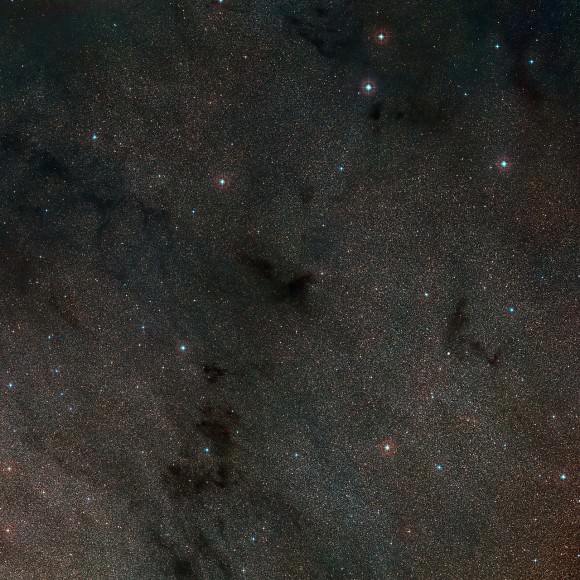What may appear at first glance to be an eerie, empty void in an otherwise star-filled scene is really a cloud of cold, dark dust and molecular gas, so dense and opaque that it obscures the distant stars that lie beyond it from our point of view.
Similar to the more well-known Barnard 68, “dark nebula” LDN 483 is seen above in an image taken by the MPG/ESO 2.2-meter telescope’s Wide Field Imager at the La Silla Observatory in Chile.
While it might seem like a cosmic no-man’s-land, no stars were harmed in the making of this image – on the contrary, dark nebulae like LDN 483 are veritable maternity wards for stars. As their cold gas and dust contracts and collapses new stars form inside them, remaining cool until they build up enough density and gravity to ignite fusion within their cores. Then, shining brightly, the young stars will gradually blast away the remaining material with their outpouring wind and radiation to reveal themselves to the galaxy.
The process may take several million years, but that’s just a brief flash in the age of the Universe. Until then, gestating stars within LDN 483 and many other clouds like it remain dim and hidden but keep growing strong.

Located fairly nearby, LDN 483 is about 700 light-years away from Earth in the constellation Serpens.
Source: ESO


How would a star look up close, let’s say, 1 year before fusion ignition? Would it look like an oversized Jupiter? Would it be bright or dark?
“As their cold gas and dust contracts and collapses new stars form inside them, remaining cool until they build up enough density and gravity to ignite fusion within their cores.”
I think this description is a bit misleading. How I’ve understood it is that the baby star already shines brightly before the fusion begins, radiating away the gravitational potantial energy turned into heat. From the outside you can’t really observe the beginning of the fusion except from the stopping of the contraction and possibly from the outflow of the neutrinos created in the fusion reactions.
I’m not an astrophysicist so someone please correct me if what I said is totally wrong. 😀
Sounds right to me, though I recall most of that luminosity before fusion would be in the form of infra-red and so it would remain dark in the visible spectrum for a while longer.